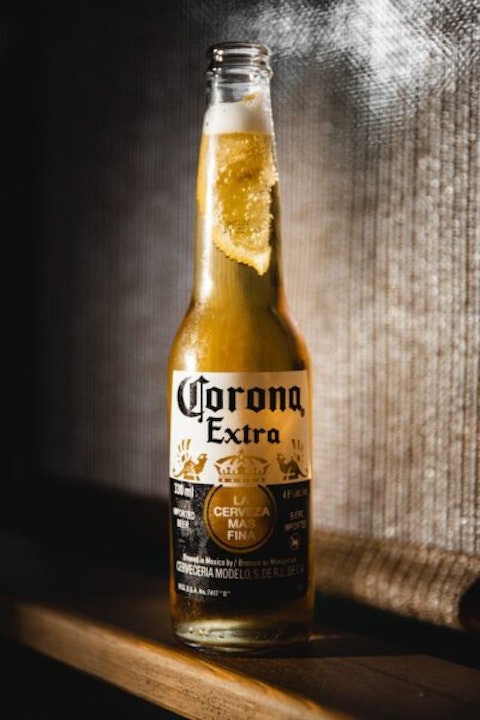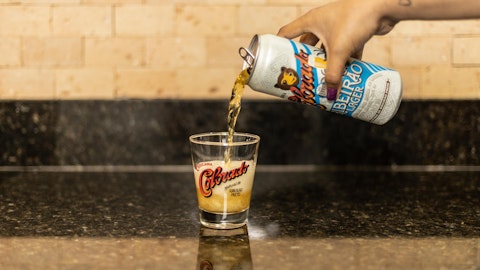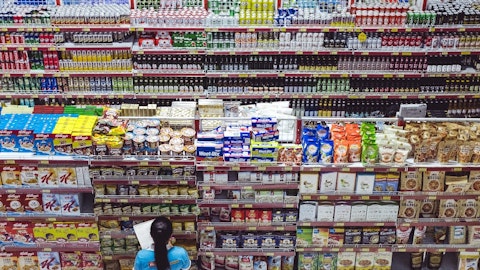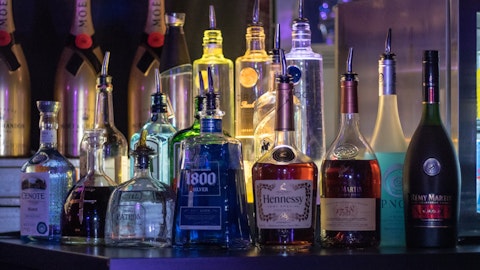Anheuser-Busch InBev SA/NV (NYSE:BUD) Q4 2022 Earnings Call Transcript March 2, 2023
Operator: Welcome to Anheuser-Busch InBev’s Full Year and Fourth Quarter 2022 Earnings Conference Call and Webcast. Hosting the call today from AB InBev are Mr. Michel Doukeris, Chief Executive Officer; and Mr. Fernando Tennenbaum, Chief Financial Officer. To access the slides accompanying today’s call, please visit AB InBev’s website at www.ab-inbev.com, and click on the Investors tab and the Reports and Results Center page. Today’s webcast will be available for on-demand playback later today. At this time, all participants have been placed in a listen-only mode and the floor will be open for your questions following the presentation. Some of the information provided during the conference call may contain statements of future expectations and other forward-looking statements.
These expectations are based on management’s current views and assumptions and involve known and unknown risks and uncertainties. It is possible that AB InBev’s actual results and financial condition may differ, possibly materially, from the anticipated results and financial condition indicated in these forward-looking statements. For a discussion of some of the risks and important factors that could affect AB InBev’s future results, see risk factors in the Company’s latest annual report on Form 20-F filed with the Securities and Exchange Commission on the 18th of March, 2022. AB InBev assumes no obligation to update or revise any forward-looking information provided during the conference call and shall not be liable for any action taken in reliance upon such information.
It is now my pleasure to turn the floor over to Mr. Michel Doukeris. Sir, you may begin.
Michel Doukeris: Thank you, Jessie, and welcome, everyone, to our full year 2022 earnings call. It is a great pleasure to be speaking with you all today. Today, Fernando and I will take you through our full year and fourth quarter operating highlights and provide you with an update on the progress we’ve made in executing our strategic priorities. After that, we will be happy to answer your questions. Let’s start with our operating performance. We are very pleased with the continued momentum of our business and the strength of the beer category across our footprint in both the fourth quarter and the full year 2022. For the full year, our top line grew by 11.2%, with volumes increasing by 2.3%, reaching a new all-time high. Revenue per hectoliter increased by 8.6% accelerating in the second half of the year, driven by revenue management initiatives and continued premiumization.
Driven by the consistent execution of our strategy and top line growth across all operating regions, our reported revenue is now $5.5 billion above full year €˜19 pre-pandemic levels, with our volumes 5.8% ahead. EBITDA increased by 7.2%, at the upper end of our medium-term growth ambition and 2022 outlook. Underlying EPS was $3.03, a 5.2% increase versus last year. As a result of our performance and strong free cash flow generation, gross debt decreased by $8.9 billion this year, leading to a net debt-to-EBITDA ratio of 3.51 times. Following our deleveraging progress, the Board has proposed a full year dividend of €0.75 per share, a 50% increase versus 2021. In the fourth quarter, we delivered top line growth of 10.2%, with accelerated revenue per hectoliter growth of 11.2%, driven by the implementation of price actions, ongoing premiumization and other revenue management initiatives.
Our volumes declined by 0.6%, driven primarily by the significant impact of COVID restrictions in China and a softer industry in the U.S. which was impacted by the phasing of price increases and abnormally cool weather in December. We delivered an EBITDA growth of 7.6% and underlying EPS of $0.86, a $0.12 increase versus quarter four €˜21. Our diverse geographic footprint provides a unique combination of growth and reliable cash flow generation, positions us well to deliver superior value creation. In 2022, we delivered broad-based growth with a top line increase in all five of our regions and volume growth in over 60% of our markets. Now, let me take you through the operational highlights for the year from our key regions, starting with North America.
In the U.S., we continue to transform and premiumize our portfolio. Our business delivered another year of top line growth and stable EBITDA, despite the elevated cost environment. Our above core portfolio continued to outperform the industry this year and combined with our Beyond Beer brand now represents over 40% of our revenue. While industry volumes in the fourth quarter were soft, we are seeing improved performance to start 2023, with year-to-date beer industry volumes down 1%, and U.S. dollar sales up 5% through the 12th of February, according to IRI. Our business in Middle Americas continues to deliver outstanding results. In Mexico, we delivered another year of double-digit top and bottom line growth, with record high volumes continue to outperform the industry.
Volume growth was broad-based across all segments of our portfolio with our above core beer brands growing over 20%. In the fourth quarter, we completed our Oxxo channel expansion with our portfolio now available in approximately 20,000 Oxxo stores nationwide. Looking ahead, we are focused on continuing to build the partnership and we are excited by the opportunity to activate our brands and gain our fair share across the network. In Colombia, our business delivered double-digit top and high single-digit bottom line growth, led by the consistent implementation of our category expansion levels. The beer category continued to grow, gaining 80 basis points share of total alcohol this year and with 2022 marking the highest beer per capita consumption in over 25 years.
Moving on to South America. Our business in Brazil reached record high volumes and grew top and bottom line by double digits as we continue to expand our market share. Our performance this year was led by over 20% revenue growth of our premium and super premium brands. Now let’s talk about EMEA. In Europe, we grew top line by double digits and EBITDA by high single digits. Our portfolio continues to premiumize with over 55% of our revenue now coming from premium and above premium brands. In South Africa, we delivered record high volumes this year, growing both top and bottom line by double digits, despite capacity constraints in the fourth quarter. And finally, APAC. In China, both the industry and our business were impacted by significant COVID-19 restrictions throughout the year, leading to a total revenue decline of 4.2% and EBITDA decline of 10.8%.
While 2022 was a disrupted year, underlying demand outside of COVID-19 restrictions remained strong. As restrictions have eased and infection rates declined, we are optimistic about the industry recovery and returning to growth as channel traffic and mobility normalizes in China. Now, I would like to share with you a few highlights of the progress across our sustainability priorities. Our priorities are centered around the beer category, which is inclusive, natural and local. With these priorities embedded into our commercial strategy, we can create value and share prosperity for our business, our communities and our planet. We continue to make progress across our priorities. Highlights include: investing over $700 million since 2016 in social norms market campaigns, promoting Smart Drinking and Moderation, reducing Scope 1 and 2 absolute emissions by 39% and improving water efficiency by 14% versus our 2017 baseline.
We are working with nearly 24,000 farmers in our direct sourcing programs through research, technology and hands-on support to help skill, connect and financially empower them. Additionally, we progressed our circular packaging goal, with 77% of our products now in packaging that is returnable or made from majority recycled content; kicked off Cohort of our 100+ Accelerator, program that continues to densify breakthrough sustainable and innovative solutions; increased representation of women in the top 5 leadership levels of our business from 19% in 2017 to 28% today. Now, let’s move on to our strategic pillars. Let’s start with pillar number one, lead and grow the category. This year, our volume reached all-time high with growth across more than 50% of our markets.
This is a direct result of our commitment to lead and grow the category by investing in our brands, innovation and category expansion levers. Our total volumes are now 5.8% ahead of pre-pandemic levels. Our above core beer brands have led the growth, increasing almost 17% versus 2019; with Corona, the star performer, growing volumes by 42% outside of Mexico. Despite the challenge of COVID-19, we invested an average of $7 billion per year over the last four years. On a currency-neutral comparable basis, in 2022, we invested more than $400 million in sales and marketing versus 2019. The consistent investments combined with our digital capabilities and increased effectiveness is driving the power of our portfolio and organic growth of our business.

Photo by Jeff Vanderspank on Unsplash
In 2022, we are named Creative Marketer of the Year by Cannes, the Most Effective Marketer Worldwide at the Effie Awards, and the number one advertiser in the Creative 100 by the WARC Advertisement Research Center. Once again, congratulations to our teams and partners for these truly remarkable achievements. We continued to execute on our five levers to drive category expansion and delivered a strong year of consistent and profitable top line growth. We are making the category more inclusive, offering superior core propositions, developing consumption occasions, and expanding our premium and Beyond Beer portfolios. Our global brands continue to scale and are driving premiumization across our markets. The combined revenues of Corona, Stella Artois and Budweiser, grew by 8.9% outside of the brand’s home market, led by Corona, which grew by 18.6%.
Budweiser growth of 2.5% outside of the U.S. was significantly impacted by COVID-19 restrictions in China, the brand’s largest market. Excluding China, the brand grew revenue by 12.6% in 2022. Innovation continued to support category expansion across each of the five pillars with innovations contributing approximately $5 billion in net revenue in 2022. From expanding our non-alcohol beer portfolio by launching Corona Cero in 11 countries to growing our Beyond Beer portfolio by scaling Cutwater and NÃœTRL within the U.S., our focus remains on driving sustainable long-term growth. Now, let’s turn to our second strategic pillar, digitize and monetize our ecosystem. This continues to accelerate, usage and reach, capturing $32 billion in GMV this year, a 60% increase year-over-year, reaching 3.1 million monthly active users.
Since BEES began its rollout in 2019, our initial focus market have strengthened customer engagement with the weighted average Net Promoter Score improving to positive 56 as of year-end 2022. In 15 of the 20 markets where BEES is live, our customers are also able to purchase third-party products to BEES Marketplace. Customer adoption is increasing with 56% of BEES customers now also BEES Marketplace buyers. In 2022, BEES Marketplace generated approximately $850 million in revenue. As an example of how BEES is improving our business and enabling us to be a better partner to our customers, let’s take a look at one of our countries, Brazil. BEES is enabling us to be closer to our customers and solve their most pressing pain points. Since the rollout of BEES in 2019, we have expanded our customer base in Brazil by over 250,000 plus, increased the total number of annual delivers by 3 million deliveries and broadened the availability of our portfolio.
And most importantly, our relationship with our customers has improved significantly, with NPS score increasing by 24 points. Digital transformation is a key pillar of our strategy and has enabled our accelerated growth in Brazil. Since 2019, the beer category has gained share of total alcohol with beer market share expanded and our beer volume grew by 17%. One key learning from BEES is when our customers grow, we grow. Now, let’s talk about how we are strengthening our relationship with our consumers. Our digital D2C products, Zé Delivery, TaDa and PerfectDraft are now available in 17 markets and generated over $450 million in revenue and 69 million orders this year. That is 69 million opportunities to better understand our consumers and their consumption occasions.
The FIFA World Cup offered an exciting opportunity for our digital DTC platforms as we launched the biggest digital campaign in our history. Our D2C activation yielded impressive results, increasing daily average orders during FIFA World Cup and attracting nearly 0.5 million new consumers to our platform. With that, I would like to hand it over to Fernando to discuss the third pillar of our strategy, optimize our business. Fernando, over to you.
Fernando Tennenbaum: Thank you, Michel. Good morning. Good afternoon, everyone. We aim to maximize value by focusing on three areas: one, optimizing resource allocation; two, robust risk management; and three, efficient capital structure. With respect to capital allocation, we are focused on maximizing long-term value creation by dynamically balancing our priorities. We continue to invest in organic growth to support our strategy to lead and grow the category, and digitize and monetize our ecosystem. The excess cash generated by our business is then dynamically allocated to our other three capital allocation priorities: deleveraging; selective M&A; and return of capital to shareholders. Investing in the organic growth of our business is our number one priority, and we have no shortage of investment opportunities.
In addition to sales and marketing, which, as Michel mentioned earlier, has averaged around $7 billion per year since 2019, we also continue to invest in our facilities and capabilities, allocating $4.8 billion in net CapEx in 2022. Over 50% of our CapEx spend is to support capacity expansions, new capabilities, digital transformation and other growth initiatives. In 2022, we invested a combined $11.7 billion in sales and marketing and net CapEx. And since 2019, we have invested over $45 billion to full growth. As you can see on slide 33, 2 times net debt-to-EBITDA remains the point at which we maximize value, though approximately 90% of the benefits from deleveraging can be captured as we approach 3 times net debt-to-EBITDA. This year, we continued to deliver strong free cash flow generating approximately $8.5 billion.
Gross debt reduced by $8.9 billion to reach $79.9 billion. As a result, we have made significant progress on our deleveraging journey with our net debt-to-EBITDA ratio reaching 3.51 times. Our debt maturity profile remains well distributed with no bond maturity in 2023 and no relevant medium-term refinancing needs. If you look at our debt maturity profile, we have $3 billion worth of bonds maturing through 2025 and more than sufficient liquidity today to redeem all of these bonds. Our bond portfolio has an average pretax coupon of around 4% and a weighted average maturity profile of approximately 15 years. Moreover, our debt portfolio does not have any financial covenants and it is comprised of a variety of currencies, diversifying our FX risk.
95% of our bonds have a fixed rate, insulated from interest rate volatility and inflation. And now, let me take you through the drivers of our underlying EPS this year. In 2022, we grew underlying EPS by 5.2% versus last year, delivering $3.03 per share. This increase was primarily driven by nominal EBITDA growth, which accounted for a $0.29 per share increase. We continue to optimize our business, reducing net interest and income taxes expenses, mostly offsetting headwinds in other line items. To simplify our disclosure, as from January 1, 2023, mark-to-market on derivatives related to the hedging of our share-based payment programs will be reported in the non-underlying net finance line. As a result, we will discontinue disclosing normalized EPS as a separate metric.
As we continue to optimize our business and bring our dynamic capital allocation priority to action, in 2022, we invested $11.7 billion in sales and marketing and net CapEx to drive organic growth. We reduced gross debt by $8.9 billion and reached a net leverage of 3.51 times. As a result of our continued momentum and consistent deleveraging progress, the Board has proposed an increase of the full year dividend by 50% versus 2021 to €0.75 per share. With that, I would like to hand it back to Michel for some final comments before we start our Q&A session. Michel?
Michel Doukeris: Thanks, Fernando. Allow me to take a few minutes to recap my key takeaways from the year and how we are prepared to continue to meet the momentum in 2023. We lead a big, profitable and growing category. Beer is resilient and is gaining share of throat globally. We made significant progress in 2022, executing across each of our three strategic pillars. Driven by the increased strength of our brand portfolio, we delivered all-time high volume and gained share across key markets. We made important strategic choices in revenue management, driving accelerated net revenue per hectoliter growth of 11.2% in the fourth quarter. We progressed our digital transformation with 63% of our revenues now digital. 56% of BEES customers are now also BEES Marketplace buyers.
And our digital D2C products fulfilled more than 69 million orders. We delivered another year of strong free cash flow and underlying EPS growth of 5.2%. As a result, the ABI Board has proposed a full year dividend of €0.75 per share. Looking ahead to 2023, we are focused on the relentless execution of our strategy and driving the momentum of our business. We have an industry-leading portfolio of brands across all price points, an advantaged geographic footprint and superior digital products that are bringing us closer than ever to our customers and consumers. We are well positioned to meet the moment in 2023 and to create a future with more cheers. With that, I will hand it back to Jesse for the Q&A.
See also 13 Most Profitable Food Stocks and 13 High Growth Pharma Stocks that are Profitable.
Q&A Session
Follow Anheuser Busch Inbev Sa Nv (NYSE:BUD)
Follow Anheuser Busch Inbev Sa Nv (NYSE:BUD)
Operator: Our first question is coming from Simon Hales with Citi.
Simon Hales: Thank you. Hi Michel, hi Fernando. I suppose a couple. My first, Michel, is really on Mexico. I wonder if you could just talk a little bit more about what’s been happening there. Clearly, Q4 volumes were a little bit weaker than the market expected, maybe a little bit slower than we saw through the first nine months of the year. But perhaps more importantly, could you talk about what — how you see that market developing as we head into 2023 and you get the full benefit of the Oxxo rollout into the North. And perhaps associated with that, what are you doing in Brazil in Oxxo stores to make sure you get your fair share of the consumer uptake? So, that’s my first one. And then my follow-up would be just around the U.S. market.
Michel, clearly you referenced sort of volumes running down about 1% for the industry year-to-date. How are you thinking about the state of the U.S. consumer for 2023? How do you think about the full year beer market trends there? And what are you seeing in terms of elasticities on your brands?
Michel Doukeris: Hey Simon. Good morning. I think I got all the questions here. We had a little bit of background noise on our side. I will go through the answers. And at the end, if I miss any point, please complement it. But starting with Mexico, I think we had a great year in Mexico. Volumes positive, share positive, top and bottom line double digits. We talked a little bit about this bad weather in the quarter four in North America. And the reality is that this expanded to Mexico as well, even though we’ve been talking a little bit less about that, but it was extremely cold, including some of the Caribbean countries where we do have operations. We think that as we look at this year, things are more normal, and we expect to see how the quarter one is going to be, and we’ll talk more as we announce results for quarter one, later.
Oxxo, we completed the last wave of our expansion, and we could not be more excited now with the opportunities to activate our brands across Oxxo, premiumize the portfolio and get our share — fair share across the network. So I think that continues to be a great opportunity as Mexico is a relevant country, Oxxo expands and we’re going to be expanding our portfolio together with them. In the U.S., I think that we saw this one-off complicated quarter on quarter four. Many things there from phasing of price increase, the effect of the two price increases of the year in one quarter and a really, really complicated weather at the back end of the quarter. As we are now with couple of weeks under the belt into January and February, the published numbers that are there, IRI numbers, they point out for volumes, give or take, 1% down, revenues close to 5% up.
And you see this very consistently across each and every week. Of course, there is phasing of Super Bowl, which is an important part of the industry in the first quarter of the year, but working well so far. Consumer and demand, resilient. We say that different than other categories, beer does not have penetration on private labels. So, we don’t see what other categories see in terms of trade down. What we see is consumers changing a little bit channels and changing a little bit package, so people buying more in larger formats, both in terms of the chains, supermarkets and the packs and people staying more at home. So penetration and consumption at home is being bigger, which in a way is very good for beer because beer has higher share of throat in home than out of home.





